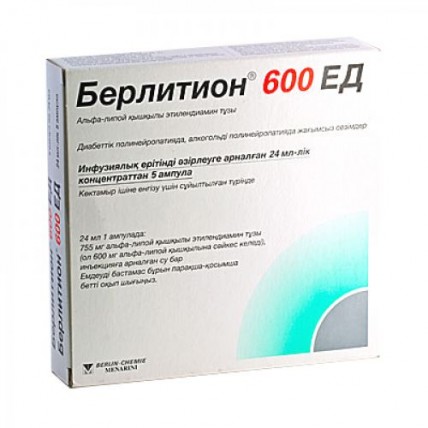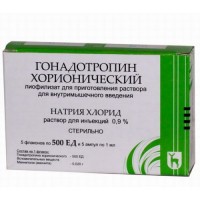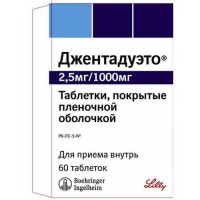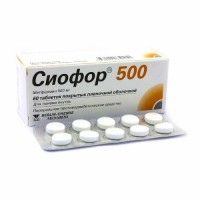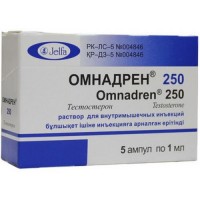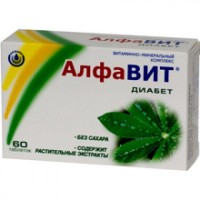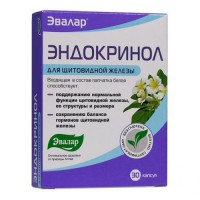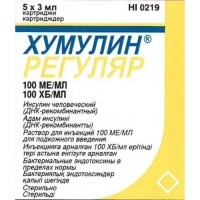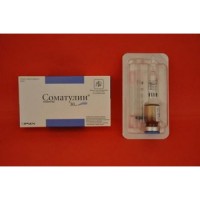Berlithion® (Lipoic Acid/Thioctic Acid) 600 mg/24ml (5 vials x 25 ml)
- $60.40
Dosage form - Concentrate for preparation of infusion solution 600 mg / 24 ml
24 ml of concentrate contains the active substance - ethylenediamine salt of alpha-lipoic acid 755 mg (which corresponds to 600 mg of alpha-lipoic acid),
excipients: water for injection, nitrogen, argon.
- diabetic polyneuropathy
- alcohol-related polyneuropathy
With significantly pronounced symptoms of polyneuropathy at the beginning of treatment in adults, intravenous administration of a concentrate is recommended to prepare an infusion solution at a dose of 24 ml per day (1 ampoule of Berlithion® 600 IU, which corresponds to 600 mg of alpha-lipoic acid) for 2-4 weeks.
To prepare the infusion solution, 1 ampoule of Berlithion® 600 U is diluted with 250 ml of 0.9% sodium chloride solution and injected intravenously for at least 30 minutes.
Due to the sensitivity of the active substance to light, the infusion solution must be prepared immediately before use. The infusion solution must be protected from light with aluminum foil. The prepared infusion solution is suitable for use within 6 hours after preparation, provided it is stored in a dark place.
As a follow-up therapy, 300-600 mg of alpha-lipoic acid are prescribed per day in dosage forms intended for oral administration.
The basis of therapy for diabetic polyneuropathy is the optimal correction of diabetes.
Often (> 1/100 - <1/10 cases)
- a feeling of heaviness in the head and tightness in the chest (after a quick intravenous injection of the drug), which go away on their own
Sometimes (> 1/1000 - <1/100 cases)
- urticaria, itching, eczema, skin rash
Very rare, including isolated cases (<1/10 000 cases)
- change or impairment of taste perception, in some cases - convulsions, double vision
- hypoglycemia, manifested by dizziness, sweating, headaches and visual impairment
- pinpoint hemorrhages in the mucous membranes and skin, hemorrhagic rash (purpura)
- burning pain at the injection site
- systemic allergic reactions up to anaphylactic shock
- hypersensitivity to thioctic (alpha-lipoic) acid or other components of the drug
- pregnancy and lactation
- children and adolescents up to 18 years old
Berlithion® 600 ED reacts with complexes containing metal ions (for example, with cisplatin). Therefore, with the simultaneous appointment with Berlithion® 600 ED, a decrease in the effectiveness of cisplatin is noted.
With simultaneous use, the hypoglycemic effect of insulin and oral antidiabetic drugs may increase, so regular monitoring of blood sugar levels is recommended, especially at the beginning of therapy. In some cases, it may be necessary to reduce the dose of insulin or the dose of oral antidibetics to avoid lowering blood sugar levels.
Berlithion® 600 ED forms poorly soluble complex compounds with dextrose molecules (including levulose solutions).
Berlithion® 600 U is incompatible with dextrose solutions, Ringer's solution, as well as with solutions known to react with SH-groups or disulfide bridges.
Regular alcohol intake is a significant risk factor for neuropathy and the progression of this disease, and for this reason it can reduce the therapeutic effect of Berlithion® 600 IU. Therefore, patients are advised to refrain from taking alcoholic beverages both during treatment with the drug and during periods outside of treatment.
Features of the effect of the drug on the ability to drive a vehicle or potentially dangerous mechanisms
Berlithion® 600 ED does not affect psychomotor functions, however, due to possible side effects after rapid intravenous administration of the drug (feeling of heaviness in the head, convulsions, double vision), caution should be exercised during work that requires concentration of attention, and while driving or servicing machines.
Symptoms: nausea, vomiting and headaches. When taking a dose of 10 to 40 g of alpha-lipoic acid in combination with alcohol, severe intoxication was observed, in some cases with a fatal outcome. The clinical picture of poisoning at first can be expressed in psychomotor agitation or clouding of consciousness and then proceeds typically, with attacks of generalized seizures and the development of lactic acidosis. As the consequences of high-dose alpha-lipoic acid intoxication, hypoglycemia, shock, rhabdomyolysis, hemolysis, disseminated intravascular coagulation (DIC) of blood, bone marrow suppression and multiorgan failure can be observed.
Treatment: immediate hospitalization and initiation of measures in accordance with generally accepted principles of treatment for poisoning (induction of vomiting, gastric lavage, activated charcoal, etc.). Relief of generalized seizures, elimination of lactic acidosis and all other life-threatening consequences of intoxication should be oriented towards modern principles of intensive care and be symptomatic. Currently, there are doubts about the usefulness of hemodialysis, hemoperfusion methods or hemofiltration in the framework of the forced elimination of alpha-lipoic acid.
Store the drug out of the reach of children and protected from light at a temperature not exceeding 25 ° С
Shelf life - 3 years
Once diluted and protected from light, the shelf life is 6 hours.
After the expiration date, the medicinal product cannot be used.
24 ml of concentrate contains the active substance - ethylenediamine salt of alpha-lipoic acid 755 mg (which corresponds to 600 mg of alpha-lipoic acid),
excipients: water for injection, nitrogen, argon.
Indications for use
- diabetic polyneuropathy
- alcohol-related polyneuropathy
Method of administration and dosage
With significantly pronounced symptoms of polyneuropathy at the beginning of treatment in adults, intravenous administration of a concentrate is recommended to prepare an infusion solution at a dose of 24 ml per day (1 ampoule of Berlithion® 600 IU, which corresponds to 600 mg of alpha-lipoic acid) for 2-4 weeks.
To prepare the infusion solution, 1 ampoule of Berlithion® 600 U is diluted with 250 ml of 0.9% sodium chloride solution and injected intravenously for at least 30 minutes.
Due to the sensitivity of the active substance to light, the infusion solution must be prepared immediately before use. The infusion solution must be protected from light with aluminum foil. The prepared infusion solution is suitable for use within 6 hours after preparation, provided it is stored in a dark place.
As a follow-up therapy, 300-600 mg of alpha-lipoic acid are prescribed per day in dosage forms intended for oral administration.
The basis of therapy for diabetic polyneuropathy is the optimal correction of diabetes.
Side effects
Often (> 1/100 - <1/10 cases)
- a feeling of heaviness in the head and tightness in the chest (after a quick intravenous injection of the drug), which go away on their own
Sometimes (> 1/1000 - <1/100 cases)
- urticaria, itching, eczema, skin rash
Very rare, including isolated cases (<1/10 000 cases)
- change or impairment of taste perception, in some cases - convulsions, double vision
- hypoglycemia, manifested by dizziness, sweating, headaches and visual impairment
- pinpoint hemorrhages in the mucous membranes and skin, hemorrhagic rash (purpura)
- burning pain at the injection site
- systemic allergic reactions up to anaphylactic shock
Contraindications
- hypersensitivity to thioctic (alpha-lipoic) acid or other components of the drug
- pregnancy and lactation
- children and adolescents up to 18 years old
Drug interactions
Berlithion® 600 ED reacts with complexes containing metal ions (for example, with cisplatin). Therefore, with the simultaneous appointment with Berlithion® 600 ED, a decrease in the effectiveness of cisplatin is noted.
With simultaneous use, the hypoglycemic effect of insulin and oral antidiabetic drugs may increase, so regular monitoring of blood sugar levels is recommended, especially at the beginning of therapy. In some cases, it may be necessary to reduce the dose of insulin or the dose of oral antidibetics to avoid lowering blood sugar levels.
Berlithion® 600 ED forms poorly soluble complex compounds with dextrose molecules (including levulose solutions).
Berlithion® 600 U is incompatible with dextrose solutions, Ringer's solution, as well as with solutions known to react with SH-groups or disulfide bridges.
Regular alcohol intake is a significant risk factor for neuropathy and the progression of this disease, and for this reason it can reduce the therapeutic effect of Berlithion® 600 IU. Therefore, patients are advised to refrain from taking alcoholic beverages both during treatment with the drug and during periods outside of treatment.
Special instructions
Features of the effect of the drug on the ability to drive a vehicle or potentially dangerous mechanisms
Berlithion® 600 ED does not affect psychomotor functions, however, due to possible side effects after rapid intravenous administration of the drug (feeling of heaviness in the head, convulsions, double vision), caution should be exercised during work that requires concentration of attention, and while driving or servicing machines.
Overdose
Symptoms: nausea, vomiting and headaches. When taking a dose of 10 to 40 g of alpha-lipoic acid in combination with alcohol, severe intoxication was observed, in some cases with a fatal outcome. The clinical picture of poisoning at first can be expressed in psychomotor agitation or clouding of consciousness and then proceeds typically, with attacks of generalized seizures and the development of lactic acidosis. As the consequences of high-dose alpha-lipoic acid intoxication, hypoglycemia, shock, rhabdomyolysis, hemolysis, disseminated intravascular coagulation (DIC) of blood, bone marrow suppression and multiorgan failure can be observed.
Treatment: immediate hospitalization and initiation of measures in accordance with generally accepted principles of treatment for poisoning (induction of vomiting, gastric lavage, activated charcoal, etc.). Relief of generalized seizures, elimination of lactic acidosis and all other life-threatening consequences of intoxication should be oriented towards modern principles of intensive care and be symptomatic. Currently, there are doubts about the usefulness of hemodialysis, hemoperfusion methods or hemofiltration in the framework of the forced elimination of alpha-lipoic acid.
Storage conditions
Store the drug out of the reach of children and protected from light at a temperature not exceeding 25 ° С
Shelf life - 3 years
Once diluted and protected from light, the shelf life is 6 hours.
After the expiration date, the medicinal product cannot be used.
